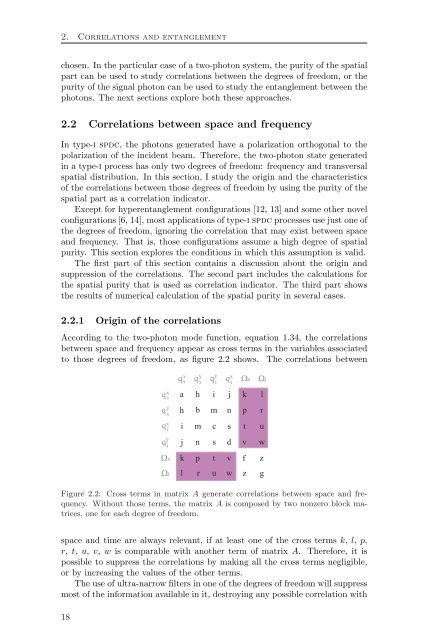Spatial Characterization Of Two-Photon States - GAP-Optique
Spatial Characterization Of Two-Photon States - GAP-Optique
Spatial Characterization Of Two-Photon States - GAP-Optique
Create successful ePaper yourself
Turn your PDF publications into a flip-book with our unique Google optimized e-Paper software.
2. Correlations and entanglement<br />
chosen. In the particular case of a two-photon system, the purity of the spatial<br />
part can be used to study correlations between the degrees of freedom, or the<br />
purity of the signal photon can be used to study the entanglement between the<br />
photons. The next sections explore both these approaches.<br />
2.2 Correlations between space and frequency<br />
In type-i spdc, the photons generated have a polarization orthogonal to the<br />
polarization of the incident beam. Therefore, the two-photon state generated<br />
in a type-i process has only two degrees of freedom: frequency and transversal<br />
spatial distribution. In this section, I study the origin and the characteristics<br />
of the correlations between those degrees of freedom by using the purity of the<br />
spatial part as a correlation indicator.<br />
Except for hyperentanglement configurations [12, 13] and some other novel<br />
configurations [6, 14], most applications of type-i spdc processes use just one of<br />
the degrees of freedom, ignoring the correlation that may exist between space<br />
and frequency. That is, those configurations assume a high degree of spatial<br />
purity. This section explores the conditions in which this assumption is valid.<br />
The first part of this section contains a discussion about the origin and<br />
suppression of the correlations. The second part includes the calculations for<br />
the spatial purity that is used as correlation indicator. The third part shows<br />
the results of numerical calculation of the spatial purity in several cases.<br />
2.2.1 Origin of the correlations<br />
According to the two-photon mode function, equation 1.34, the correlations<br />
between space and frequency appear as cross terms in the variables associated<br />
to those degrees of freedom, as figure 2.2 shows. The correlations between<br />
q s x<br />
q s y<br />
q i x<br />
y<br />
qi s<br />
i<br />
qs x<br />
a<br />
h<br />
i<br />
j<br />
k<br />
l<br />
q s<br />
y<br />
h<br />
b<br />
m<br />
n<br />
p<br />
r<br />
qi y<br />
i<br />
m<br />
c<br />
s<br />
t<br />
u<br />
Figure 2.2: Cross terms in matrix A generate correlations between space and frequency.<br />
Without those terms, the matrix A is composed by two nonzero block matrices,<br />
one for each degree of freedom.<br />
space and time are always relevant, if at least one of the cross terms k, l, p,<br />
r, t, u, v, w is comparable with another term of matrix A. Therefore, it is<br />
possible to suppress the correlations by making all the cross terms negligible,<br />
or by increasing the values of the other terms.<br />
The use of ultra-narrow filters in one of the degrees of freedom will suppress<br />
most of the information available in it, destroying any possible correlation with<br />
18<br />
q i<br />
x<br />
j<br />
n<br />
s<br />
d<br />
v<br />
w<br />
s<br />
k<br />
p<br />
t<br />
v<br />
f<br />
z<br />
i<br />
l<br />
r<br />
u<br />
w<br />
z<br />
g



